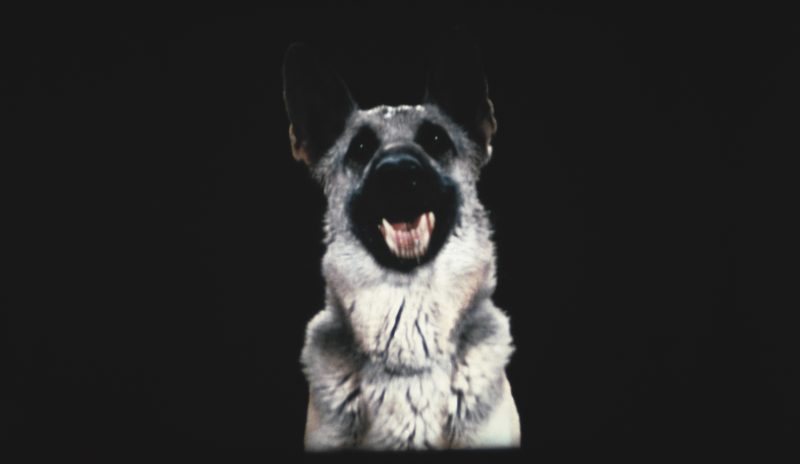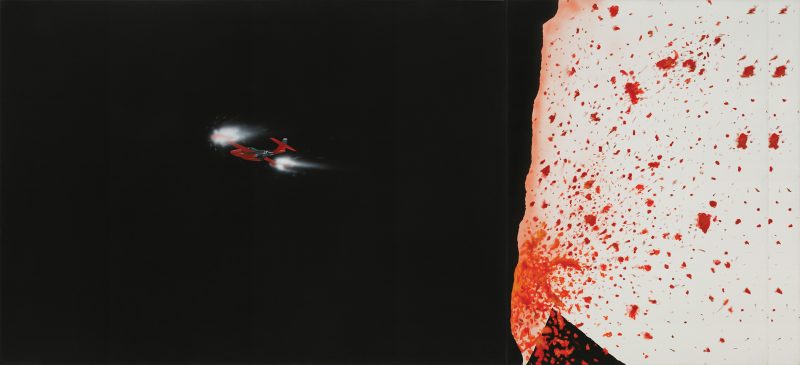“I never look at the last thing someone did for me; I look at the big picture.”
—Jack Goldstein, quoted in Jack Goldstein and the CalArts Mafia by Richard Hertz
Toward the end of John Guare’s play Six Degrees of Separation, society matron Ouisa Kittredge rebukes her husband for animatedly telling their dinner guests about a con man who inserted himself into their lives, claiming to be Sidney Poitier’s son. Ouisa is appalled that her husband would recount this humiliating, hurtful story in order to entertain and amuse their friends, when the man, in fact, had come to mean a lot to them. As she says, “We become these human jukeboxes spitting out these anecdotes to dine out on like we’re doing right now. Well, I will not turn him into an anecdote. It was an experience. How do we hold on to the experience?”
This precise dilemma presented itself often as I sat down to write about the artist Jack Goldstein. I knew Jack in the ’80s in New York, when his short-lived era of good fortune was already on the wane. I intended to share amusing or unnerving anecdotes about Jack, ones that his friends and/or enemies love to tell in glorious, bitter detail. They’re good stories; some of them may even be true. (My favorite turned out to be wholly false. In the midst of a Whitney Biennial party held at the home of a famous and self-important collector couple, Jack purportedly forced his hosts to move one of his paintings to a choicer spot in their Upper East Side townhouse.) Yet writing down these stories felt potentially more exploitative than celebratory or usefully revealing. Wouldn’t it be preferable to experience Jack’s work directly, rather than viewing it through the lens of the tittle-tattle and gossip, even if so much of the mythomania came from his own mouth, even if so much of it was a part of his persona as an artist, and responsible, to some degree, for his fame?

Thinking about Jack Goldstein, it turned out, was not much easier than knowing him.
*
Though most people remember Jack Goldstein as a failure, he was, for a brief period, a very successful artist.
Jack was born in Canada in 1945 and moved to Southern California as a teenager, where he would later attend CalArts’ hallowed post-studio program, headed up at the time by the conceptual photographer John Baldessari, who soon became Jack’s mentor. Jack’s early work was temporal and fleeting, and was best represented by his performances and films (a film called Metro-Goldwyn-Mayer shows the MGM lion roaring on a continuous loop, ad infinitum, appearing ever more powerless, even ridiculous). Jack moved to New York and soon thereafter he turned himself into a painter, in part because paintings sell and Jack needed money. He created canvases that feature images appropriated from wartime photographs of explosions and other disasters, works that sought to capture what he called the moment of the “spectacle” or “the spectacular instant.”
These were sold mostly by Helene Winer, his “woman” from the CalArts days and also one of the founders of the influential New York gallery Metro Pictures. As Metro’s power grew, Jack became the epitome of the ’80s Male Art Star (first-generation model). He was a womanizer, heavy drinker, party animal, serial self-promoter, and loved a good bust-up—physical or otherwise. He took the image of the Great Male Painter, embraced by the New York art world for decades, and added the egocentric patina of the ’70s conceptual artist. He was Franz Kline and Michael Heizer rolled into one. He was fiercely competitive and used his hostility in the same way that Jackson Pollock used his, as a means for creating large works that could epitomize a cultural moment to the nth degree.
Eventually, however, Jack self-destructed. He stopped going to his studio, relying on his assistants to churn out inferior work with his name on it; one by one, he alienated his allies, eventually turning them into enemies. His drug habit became uncontrollable and he started looking ill. Nobody wanted to talk to Jack; many people, including myself, would cross the street to avoid him when he was in a bad way.
Then Jack abandoned New York—but he didn’t just leave the city, he disappeared. It became something of a game for a while to try to figure out where Jack was. Most people figured he was dead, but then we’d hear that he’d been spotted at CalArts auditioning in his hustler way for a teaching gig, or trying to sell paintings to his old and once-dedicated collectors for a fraction of the price his works had commanded when things were going well. A mythology of failure, fueled in no small part by the schadenfreude of the many wronged people he’d left behind, filled Jack’s absence; very soon this mythology replaced whatever truth there was left of the artist he’d once been. No one was interested in his work, which was being sold on the cheap and was rarely if ever written about or discussed. He had no dealer—at least not an art dealer—and his works were taken down at museums and placed in storage to gather dust.
In his own words, Jack was “a ghost who refuses to die.”
*
For a while, around 1991 or 1992, I received occasional letters Jack sent from the Southern California desert, where he’d eventually settled. These were letters full of accusation and fiery invective. I left New York soon thereafter and I had no further contact with him. I kept the letters, strangely, even though I dumped so much else from that time. They were a scream I didn’t have the energy to pay much attention to—not that I would have known what to do had I really taken in the subtext within them.
Ten years later, in March 2003, I was reading the New York Times and saw Jack’s obituary. He’d hanged himself from a tree in front of the trailer he’d been living in for more than a decade. His various obituaries mentioned CalArts, John Baldessari, Whitney Biennials, heroin, bad behavior, Metro Pictures, Robert Longo, and David Salle. This was no surprise. With everything else in his life having withered away, these became the signposts of the life and career that people could hang on to. For the most part I thought the obits got it right. I was particularly impressed by the piece Jim Lewis wrote for Slate titled “Exile’s Return: Why You Should Know the Name Jack Goldstein.” Lewis posited that the adage “You can’t go home again” rang acutely, tragically true in Jack’s case, a psychological read that seemed, based on my experience of Jack, exactly right. Jack was a person who searched for validation from the outside, partly because he didn’t feel his own worth inside. And yet his resentment toward the people from whom he sought this validation ran too deep by the end. There was no going back and undoing what he’d done to himself. Those resentments couldn’t heal. The wound had been festering for too long.
In the months that followed Jack’s suicide, I found myself talking to people who knew Jack and to whom I myself hadn’t spoken in years. I learned through them what had happened during the time that Jack and I had been out of touch. There was a hopeful moment of rediscovery and potential career rebirth in 2002 when Jack returned to New York for a program of his films at the Whitney. He’d been invited to a series of events in his honor, events that each started out positively, then inevitably devolved. A filmmaker friend said of one reunion that she came away feeling like she’d participated in a Dogme film. That was one of Jack’s talents, I guess. He could turn a beautiful moment into a horrendous one, and vice versa. He was a provocateur not in the Warholian sense, but more in the spirit of Artaud’s Theatre of Cruelty, which was fine as long as you weren’t the guest of honor.
*
In 2001, Richard Hertz, a teacher and writer and big supporter of Jack’s, embarked upon an oral-history project called Jack Goldstein and the CalArts Mafia. Jack worked with Richard on a series of candid, sorrowful, often wrathful and grievance-airing interviews; Jack recorded his version of events on a tape recorder, after which Richard interviewed Jack’s contemporaries to get their version of the same events. (Many refused to participate.) The book was published around the time of Jack’s suicide.
I put off reading that book for almost a year. It provides a legacy for Jack (which he claims in the book he really desired), but at the same time, these reminiscences, while entertaining, can threaten to belittle the accomplishments of the artist and his circle. In too many cases, people use their moment with the tape recorder to settle old scores against ex-boyfriends or art dealers or collectors who fucked them out of a couple thousand dollars. Their testimonies not only belittle their place in history by reducing everything to anecdote, they risk diminishing their work as well.

Perhaps Jack saw the oral-history project as a kind of elongated suicide note; perhaps he found himself searingly empty once he’d voided himself of the resentments that had possibly kept him alive for so long. And perhaps the main reason people think of Jack Goldstein as a failure is because he spoke about himself as a failure. His was rage masquerading as confession, or confession masquerading as rage; regardless, perhaps he was not the best person with whom to entrust his own legacy. Then again, it was his to destroy if he wanted to.
*
Ironically, of course, Jack’s death brought him back to mild prominence again. Since 2003, there have been numerous retrospectives (mostly in Europe), and, in 2006, Metro Pictures, his original gallery, again exhibited his work, and there was a retread of the famous Pictures show at Artists Space that had helped bring him to prominence; for many young artists, it was the first time they’d ever heard of Jack Goldstein, let alone set eyes on his actual physical work. If they knew his work at all, it was through reproductions—which, given the work’s appropriational nature, is pretty interesting.
This time Jack wasn’t around to derail his own comeback.
Ultimately what I’m saying about Jack’s famously (and, yes, entertainingly) bad behavior, and his mythology of failure, is that I’m going to try to forget all of it. I never thought of Jack as a failure until I read his own words claiming to be one. As Viktor Mayer-Schönberger writes in his book Delete: The Virtue of Forgetting in the Digital Age, one of society’s great virtues and remedies is the ability to forget. If I can manage to delete what I have heard, know, and read about Jack, I might experience the work on its own terms again, and not through the obscuring veil of salaciousness, tragedy, and disappointment. That work is compelling enough on its own terms.





